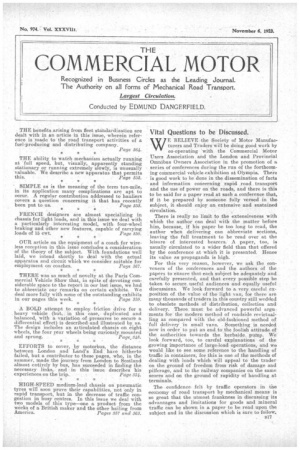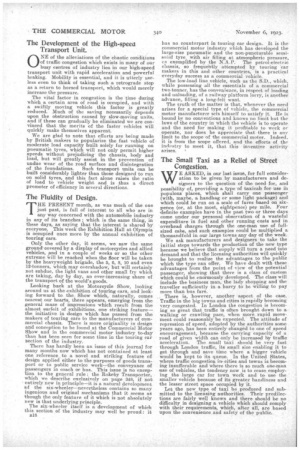Vital Questions to be Discussed.
Page 1

Page 2

If you've noticed an error in this article please click here to report it so we can fix it.
E BELIEVE -the Society of Motor Manufacturers and Traders will be doing good work by co-operating with the Commercial Motor • Users Association and the London and Provincial Omnibus Owners Association in the promotion of a series of conferences during the run of the forthcoming commercial vehicle exhibition at Olympia. There ' is good work to be done in the dissemination of facts and information concerning rapid road transport and the use of power on the roads, and there is this to be said for a paper read at such a. conference that, if it be prepared by someone fully versed in the subject, it should enjoy an extensive and sustained circulation.
There is really no limit to the extensiveness with which the author can deal with the matter before him, because, if his paper he too long to read, the author when delivering can abbreviate sections, leaving the full treatment to be read over at the leisure of interested hearers.A paper, too, is usually circulated to a wider field than that offered by the conference at which it is presented. Hence its value as propaganda is high.
For this very reason, however, we ask the conveners of the conferences and the authors of the papers to ensure that each subject be adequately and carefully presented, and that every possible step be taken to secure.useful audiences and equally useful discussions. We look -forward to a very careful exposition of the value of the light van, for there are many thousands of traders in this country still wedded to obsolete methods of distribution, collection and delivery. There • must be advanced powerful argu
• ments for the modern method of roadside revictualling as compared with the old-fashioned method of -full delivery in small vans. . Something is needed
now in order' to put an end.to the 'foolish attitudeof • the authorities towards the. kerbside. puinp. We look forward, too, to careful explanations of the growing importance of large-load operations,and we would like to see some reference to the handling of traffic in containers, for this is one of the methods of dealing with loads which will appeal to the trader on the ground of freedom from of damage and pilferage, and to the railway companies on the same scares and on the ground 'of rapidity of handling at terminals. .
The confidence felt by traffic operators in the • economy of road transport by mechanical means is so great that the utmost frankness in discussing its advantages and limitations for goods and mineral traffic Can bo shown in a. pa-per to be read upon the subject and in the discuSsiOn which is Sure to follow„
The Development of the High-speed Transport Unit.
0 NE of the alleviations of the chaotic conditions of traffic congestion which exists in many of our busy centres of industry lies in our high-speed transport unit with rapid acceleration and powerful braking. Mobility is essential, and it is utterly useless even to think of taking such a retrograde step as a, return to horsed transport, which would merely increase the pressure.
The vital factor in congestion is the time during which a certain area of road is occupied, and with a swiftly moving vehicle this factor is greatly reduced. Much of the saving necessarily depends upon the obstruction caused by slow-moving units, and if these can gradually be eliminated we are convinced that the merits of the faster vehicles will quickly make themselves apparent.
We are glad to note that efforts are being made by British makers to popularize the fast vehicle of moderate load capacity built solely for running on pneumatic tyres, which will not only permit higher speeds without prejudicing the chassis, body and load, but will greatly assist in the prevention ofundue wear of the road surface and disintegration of the foundations. Such transport units can be built considerably lighter than those designed to run on solid tyres, and this fact alone raises the ratio of load to vehicle weight and is thus a direct promoter of efficiency in several directions.
The Fluidity of Design. The Fluidity of Design.
THE PRESENT month, as was much of the one just past, is full of interest to all who are in any way concerned with the automobile industry in any of its branches; which is the same thing, in these days, as saying that the interest is shared by everyone. This week the Exhibition Hall at Olympia is occupied once more by the annual exhibition of touring cars.
Only the other day, it seems, we saw the same ground' covered by a display of motorcycles and allied vehicles, ,nd in a couple of weeks or so the other extreme will be reached when the floor will be taken by the heavyweight brigade, the 5, 6, 8, 10 and even 12-tonners, which may overshadow, but will certainly not subdue, the light vans and other small fry which are taking, day by day, an ever-increasing share of the transport of the world's goods.
Looking back at the Motorcycle Show, looking around us at the exhibition of touring cars, and looking forward to the Show which, naturally, comes nearest our hearts, there appears, emerging from the general maze of impressions which result from the almost surfeit of exhibitions, one striking feature— the initiative in design which has passed from the makers of touring cars to the manufacturers of commercial chassis. There is more originality in design and conception to be found at the Commercial Motor Show and in the commercial motor industry to-day than has been seen for some time in the touring car section of the industry.
There has hardly been an issue of this journal for many months now which has not contained at least one reference to a novel and striking feature of design applied either to the purposes of goods transport or to public service work—the conveyance of passengers in coach or bus. This issue is no exception to the general rule : the Rokeby Transporter, which we describe exclusively on page 348, if not entirely new in principle—it is a natural development lof the six-wheeler—nevertheless contains so many ingenious and original mechanisms that it seems as though the only feature of it which is not absolutely new is that underlying principle. The six-wheeler itself is a development of which this section of the industry may well be proud: it B18 has no counterpart in touring ear design. It is the commercial motor industry which has developed the large-size pneumatic and the non-puncturable semisolid tyre with air filling at atmospheric pressure, as exemplified by the N.A.P. The petrol-electric chassis, so frequently attempted by touring "car makers in this and other countries, is a practical everyday success as a commercial vehicle.
The low-load line vehicle, such as the S.D., which, while possessing all the essentials of a commercial two-tonner, has the convenience, in respect of loading and unloading, of a railway platform lorry, is another advance, filling a long-felt want.
The truth of the matter is that, whenever the need arises for a special type of vehicle, the commercial motor manufacturer sets himself to satisfy it. He is bound by no conventions and knows no limit but the laws of the country in which the vehicle is to operate and the need for making it profitable to work or operate, nor does he appreciate that there is any limit to the scope of the commercial motor. Indeed, it is from the scope offered, and the efforts of the indestry to meet it, that this inventive activity arises. '
The Small Taxi as a Relief of Street Congestion.
WE ASKED, in our last issue, for full consideration tot be given by manufacturers and designers to the question of the Deed for, and possibility of, providing a type of taxicab for use in populous places, which shall carry one passenger (with, maybe, a handbag or some light package) and which could be run on a. scale of fares based on sixpence (or, at the most, eightpence) per mile. Four definite examples have in the past two or three days come under our personal observation of a wasteful expenditure in fuel and other running costs and in overhead charges through the one-man use of fullsized cabs, and such examples could be multiplied a thousandfold in our large towns any day of the week.
We ask manufacturers and designers to take the initial steps towards the production of the new type because we believe that supply will turn a need into demand and that the licensing authorities will quickly be brought to realize the advantages to the public which the type can offer. We have dealt with these advantages from the point of view of the potential passenger, showing that there is a, class of custom which could be enormously developed. The class will include the business man, the lady shopping and the traveller sufficiently in a hurry to be willing to pay more than bus fare.
There is, however, another-aspect of the case. Traffic in the big towns and cities is rapidly becoming very congested. In London the congestion is becoming so great that ;traffic is often brought down to a walking or crawling pace, when more rapid movement could reasonably be expected. The attitude of repression of speed, adopted by the authorities some years ago, has been entirely changed to one of speed encouragement, because the carrying capacity of a road of given width can only be increased br traffic acceleration. The small taxi should be very fast through London traffic, its small size enabling it to get through and save time where a bigger vehicle would be kept to its queue. In the United States, where traffic congestion in cities and towns is becoming insufferable and where there is so much one-man use of vehicles, the tendency now is to cease employing the large car for town work and to use the smaller vehicle because of its greater handiness and the lesser street space occupied by it.
Let the new type of taxi be produced and submitted to the licensing authorities. Their predilections are fairly well known and there should be no difficulty in designing a vehicle which should comply with their requirements, which, after all, are based upon the convenience and safety of the public.
































